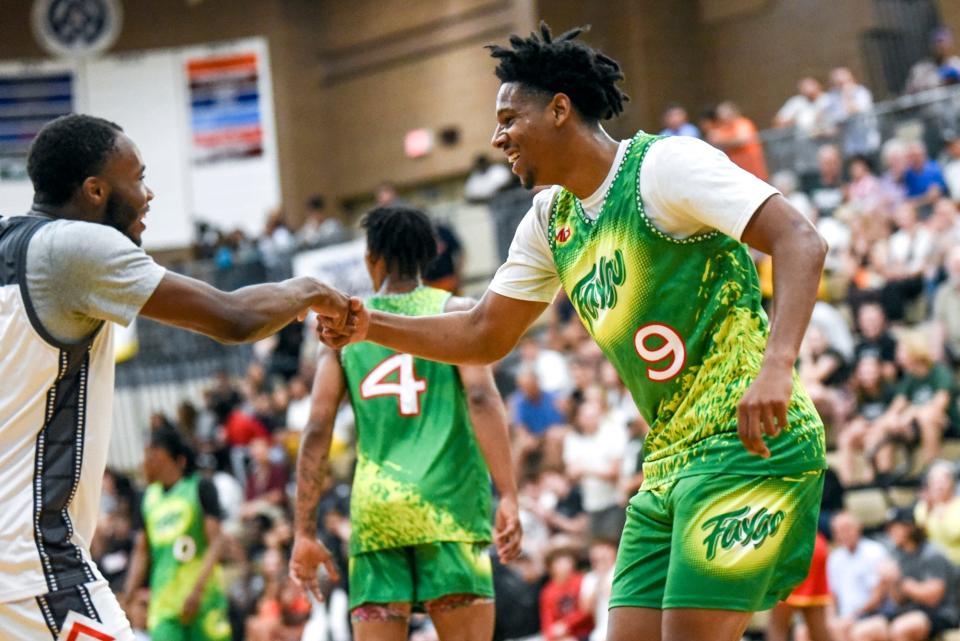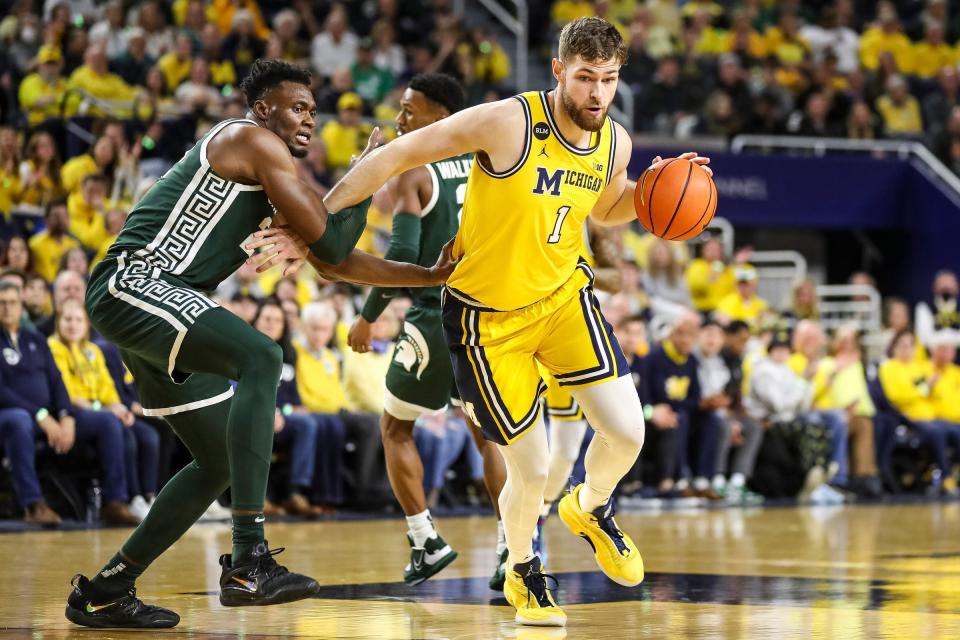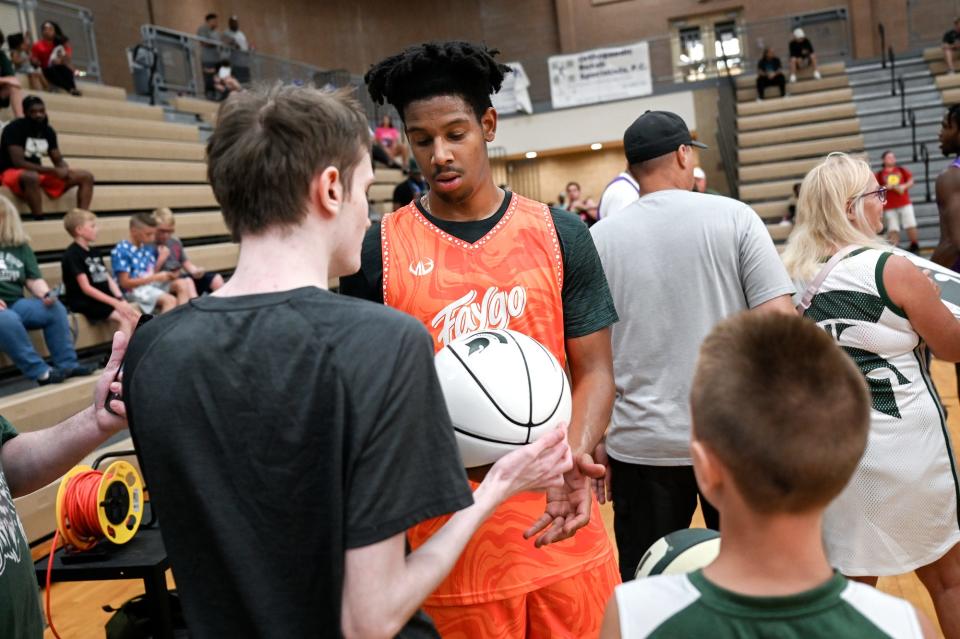It's the unintended consequences of NIL that threaten to undo college sports
HOLT — A.J. Hoggard spent two days this week dashing up and down the court at Holt High School as part of the Moneyball Pro-Am league. That was sandwiched around Michigan State basketball’s summer team workouts and weightlifting.
On Friday, the senior point guard picked up his phone and put some money in his bank account. All he needed was to thumb out a tweet with a picture of himself promoting a sneakerhead store across the street from campus in East Lansing.
At its core, that was the essence of how many envisioned college athletes could capitalize on their name, image and likeness when laws went into effect two years ago. And four years after retiring, former MSU deputy athletic director Greg Ianni loves seeing that finally coming to fruition.

It is many of the other unintended happenings and consequences around the country, however — from the forming of NIL collectives by boosters of schools to players now utilizing both the opportunity to make more money elsewhere and the transfer portal as negotiating leverage — that threaten to undo the modern fabric of college sports.
“I think the athletes deserve the NIL thing,” Ianni recently told the Free Press. “But once again, there are people that are going to take a good idea and make it not such a good idea. NIL was never intended to be a recruiting benefit. It was never intended to be, but that's what it is now.”
SHAWN WINDSOR: Michigan State basketball incredibly deep and talented: How will Izzo meld it together?
Collective growth
MSU is among those universities at the forefront of the NIL collectives, with the two most prominent — SD4L (which stands for Spartan Dawgs For Life) and This is Sparta — connecting high-profile donors with former athletes over the past two years to work as a conduit to current Spartans in football and basketball. Football players last year also created their own collective, the East Lansing NIL Club.
A few MSU teams also had a blanket deal with alum Mat Ishbia’s United Wholesale Mortgage to promote the company on social media the past year, though the deal ended last month because of a perceived conflict of interest when the former basketball walk-on-turned-billionaire became the owner of the NBA’s Phoenix Suns. Other sports’ rosters have partnerships with other organizations, such as the women’s basketball team’s group deal with MSU Federal Credit Union.

Two years ago, none of those things existed as the first NIL laws around the country went into effect and the NCAA was forced to back away from the restrictions they had created and enforced for decades. That came about because of a few major rulings against the collection of colleges and universities in the Supreme Court in recent years.
But by the summer of 2021, the NCAA had yet to enact changes. That was, until state legislatures began forcing them to with a series of laws essentially rendering the organization toothless in enforcing its interim rules and revisions since.
Florida-based attorney Darren Heitner, who has represented former MSU basketball player Draymond Green in marketing deals, helped lead a fight that saw what was taboo in the first half of 2021 transform into an open marketplace a day after the NCAA’s interim rules went into place, on June 30 that year.
Heitner said five states recently have modified their own NIL laws “to now overtly say the NCAA can't punish or investigate schools within their jurisdiction.”
“The NCAA had years, if not decades, to plan for this. And yet, it seems as though everything … has the feel as this as though these things have not been well-thought through,” Heitner told the Free Press on Friday. “As though you get a gathering of individuals who off on the whim decide certain rules and regulations without any enforcement, without any mechanism to enforce and with a real fear to enforce any of their rules. ...
“But the rules are very basic, they're vague, they're ambiguous, they've never been enforced. And now you have states like Missouri, saying, 'To heck with your main rule,' which is that there can't be inducements to athletes to persuade them to commit to or attend a university, 'we're going to codify in our state, well, that's acceptable.' That's where we are now.”
ON THE OTHER HAND ... : Michigan athletics finds its footing in NIL world. Here's what took so long
Along with those new rights for athletes have come a new landscape for college sports. Heitner worked with former University of Florida baseball player Eddie Rojas to form what became the Gator Collective, the first organization bringing together university donors in a group that signed athletes to relatively loose marketing deals. That launched less than two months after the first rules went into effect in the summer of 2021, with other groups at other schools popping up afterward and using a similar nomenclature.
Ianni, an MSU alum who worked for nearly 40 years in athletic administration before retiring in 2019, feels the way collectives have emerged “have widened the gap between the haves and have-nots, which I was fearful that was going to happen.”
“What the collectives have done, they collect money, and they just distribute it, they just hand it out,” Ianni said. “That's contrary, to me, to the spirit of what the rule is. That is how they're working around that. … I worked with a coach a number of years ago, when I first got in it about 40 years ago, an Ohio University football coach. Good guy. And he had one rule for his team. And the rule was, 'Abuse leads to restriction.'
“You can you could say that about so many things in life, and we can see it every day. People make rules with good intentions. But there's always going to be somebody that's going to take that rule and turn it around so it turns into something that's bad. And that's what's happened here.”
LEAVING EAST LANSING: Keon Coleman explains why he transferred from Michigan State to Florida State
Portal power

Both Ianni and Heitner are in agreement: The NCAA’s inaction over the past decade created the current chaos.
Ianni, a former MSU baseball player whose daughter Allison (volleyball) and son Anthony (basketball) both were Spartan athletes, said he is frustrated from afar watching the NCAA mostly avoid making decisions over the past two years.
“Anything they do, any rule they make, it's gonna get challenged (in court),” he said. “If it looks like it's restricting the opportunity for the student-athlete to do what everybody else in the country does, to have the fair opportunity to go out and make a living if you will, they know they're gonna lose those cases. ... That's what's created the wild, wild West.”
That volatility also comes with the NCAA granting athletes the ability to transfer once and be immediately eligible at their new school. It has led to players and their representation weaponizing the transfer portal for leverage in negotiations this year. MSU football, for instance, had junior wide receiver Keon Coleman leave after spring workouts for Florida State.
Heitner watched this spring as former Michigan center Hunter Dickinson transferred to Kansas and was vocal about some of the money being thrown at him as he was in the transfer portal. It confirmed what the professional sports agent predicted would happen: “Unrestricted free agency" had arrived in college.
“Every single athlete has a one-time shot to basically enter into free agency and, if he or she so chooses, go to the highest bidder,” Heitner said. “I saw (Dickinson’s) quote where he ultimately said, 'Well, I didn't go to the highest bidder,' but then also either expressly or impliedly stated that there were multiple offers on the table — which, by the way, it's against NCAA rules for there to be offers while a player is in the transfer portal — and that they were at a very high clip, a big amount of money that was being offered from multiple schools.
“It's not true for every athlete. But the more marketable ones, the ones who have the talent, they can use the transfer portal as an opportunity to really explore the market and pit schools against each other and collectives against each other and go to the highest bidder if they so choose. It's quite a bit of empowerment for the athlete, for sure.”
MITCH ALBOM: College athletes jumping schools should skip the teary goodbyes
New reality

All this leaves athletes such as Hoggard, who arrived at MSU the year before NIL rules went into effect, learning along the way about the new power they possess. Staying in college no longer is just about improving your game but also part of the business equation for high-end athletes — should they test the pro path early or stay in school?
Hoggard, a 22-year-old advertising management major, said another unintended consequence of gaining that ability to market himself is getting contacted constantly over social media by people and companies who are seeking his services. He said he hired a representative to handle those inquiries, to help keep most of his focus on basketball and chasing his NBA dream.
“The ultimate goal is to play professionally. And when you're a professional, you get paid,” said Hoggard, who entered and withdrew from the NBA draft in the spring. “And when you're a professional, you got to carry yourself at a certain level. So just being part of that now early, you always had to be a professional whether you were getting paid or not as a college athlete or as an athlete in general. You'd have to conduct yourself with good character and high integrity.
“But also with this, it's just another compartment that's preparing us for the next level. I think it's just helping us get ready to learn how to use our money, how to spend our money, how to use our money wisely. And just be smart with things that's going on.”
Just how much athletes are making remains shrouded in mystery to athletic administrators, a point new Big Ten commissioner Tony Petitti made at his first news conference in late April. That leads to supposition and innuendo on whether a player is getting paid more or less than they or their NIL agents claim.
Ianni pointed to one recruiting website that hypothesizes an athlete’s “NIL valuation” and thinks it is critical for the schools and NCAA to create a public database with firm numbers like professional leagues offer. Of course, he also believes that might lead to something else Petitti brought up: College athletics adopting a professional model to pay players.
“I think the only way it's gonna get resolved is, I think the players have to become unionized. And to me, I think they're gonna end up being employees of the institution,” Ianni said. “That way, you can negotiate a collective bargaining agreement with them, so that everybody in the country is reading from the same sheet of paper. That's the only way it's going to stop. Because right now, everybody's kind of on their own.”
Heitner took it a step further, saying he feels athletes should earn salaries as well as a share of the revenue. That's something he acknowledged would move college sports even farther from where it was a little over two years ago.
“It's immense athlete empowerment,” he said, “but I think also a lot of uncomfort for schools and policymakers at the NCAA.”
Contact Chris Solari: csolari@freepress.com. Follow him on Twitter @chrissolari.
Read more on the Michigan State Spartans and sign up for our Spartans newsletter.
This article originally appeared on Detroit Free Press: College athletes, administrators navigate unintended changes of NIL

